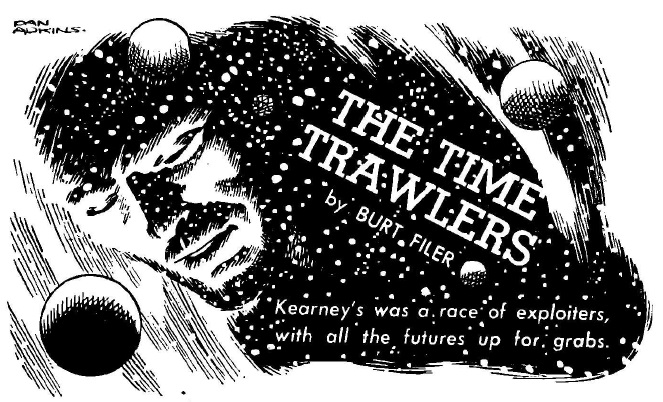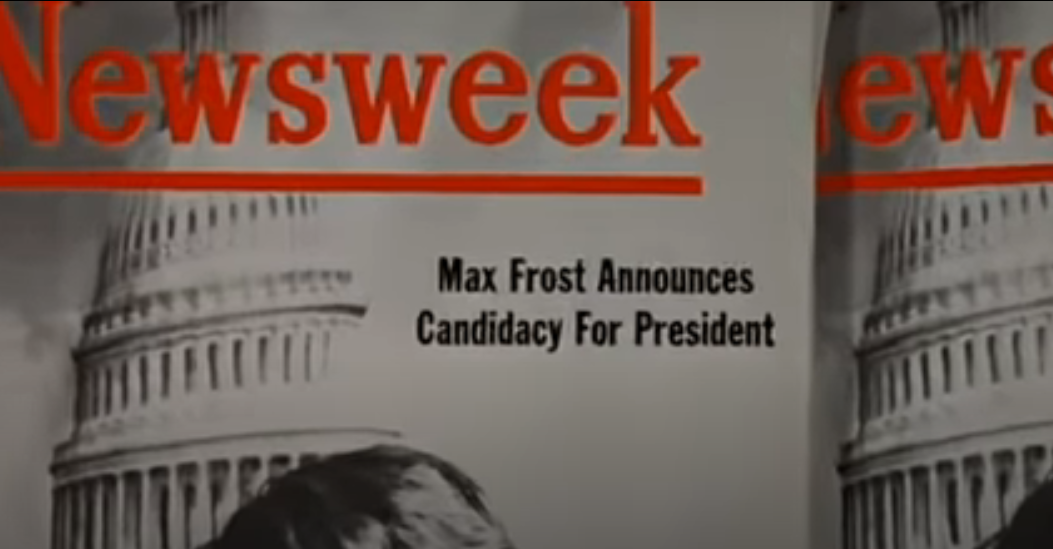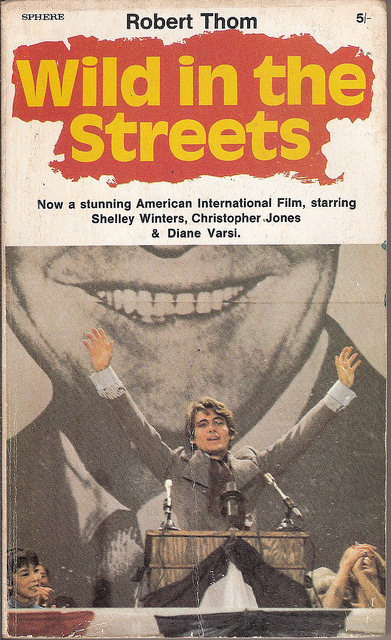
by John Boston
A few years ago, when I was reading a lot of fanzines, I came upon an article impudently titled Heinlein: By His Jockstrap, concerning attitudes towards sex in the works of Robert Heinlein. Wow! This SF fandom is pretty racy! Or so I thought. Not everyone appreciated that article, though, starting with Mr. Heinlein.

Alexei Panshin
The article’s author, Alexei Panshin, was a budding SF writer himself, having a few months earlier published the impressive Down to the Worlds of Men in If. Since then he has published more stories of varying merit, and a just-published novel, Rite of Passage, which on a first and superficial reading seems quite impressive—and, not at all ironically, quite Heinleinesque. He also published more articles about Heinlein in fanzines. You’d think the guy was working on a book.
And of course he was. But it’s more complicated than that.
The Pioneer by Invitation
According to Panshin, in another fanzine article, this one in the April 1965 Yandro, he was solicited by Advent: Publishers in 1964 to write a critical study of Heinlein’s fiction. Advent publishes books about SF, such as Damon Knight’s In Search of Wonder, James Blish’s The Issue at Hand, and the symposium The Science Fiction Novel: Imagination and Social Criticism. The proposed book would be the first book-length study of any writer from within the SF ghetto. Panshin accepted and got to work. He wrote to Heinlein, introducing himself, stating he was planning to write a book better than the “Jockstrap” article, and asking some questions about his life and work. There was no response—to Panshin, anyway.
Panshin also wrote to a number of others about Heinlein, later learning that Heinlein had been angered by these letters, and had seemingly discouraged the recipients from responding. In any case he got few responses. One who did respond was the widow of Sergeant A.G. Smith—the dedicatee of Heinlein’s Starship Troopers—who offered to let Panshin see Smith’s correspondence with Heinlein.
The 800-Pound Gorilla
Heinlein was furious, and ultimately wrote Advent a letter, which Panshin has seen and which he describes as attacking his qualifications to write the book, accusing him of employing ungentlemanly, unethical, and in part dishonorable and illegal means of gathering material, and forbidding Advent to quote from Heinlein’s copyrighted works, use his name or picture, or do anything else requiring his permission. He refused Advent’s offer to review the manuscript pre-publication, and reserved the right to sue or bring criminal action as appropriate if the book were published.
Advent, successfully intimidated, then backed out and sent Panshin a $50 kill fee, leaving him with a completed book and nowhere to go with it. His efforts to find a way to smooth things over were futile. Panshin concluded his Yandro article by quoting the man himself:
“FARNHAM’S FREEHOLD, page 88: ‘ . . . a book need never die and should not be killed; books were the immortal part of man. Book burners—to rape a defenseless friendly book.’ ”
So, what to do? What Panshin did do was to break out portions of his book manuscript (some with substantial revisions) and submit them for publication in various fanzines, mostly the solemn and prestigious Riverside Quarterly. Not surprisingly, after having all this impressive material published in a short period of time, Panshin last year received the first Hugo Award for Best Fan Writer.
Meanwhile, Advent had a change of heart. After Panshin’s award, and also after it reorganized from a partnership to a corporation (thereby protecting the former partners, now owners, from personal liability), it would publish Panshin’s book after all. And now we have it.
The Book

by Alex Eisenstein
So what exactly do we have? It’s impressive within its (self-imposed) limits. It is a work of genre criticism, explicitly in the vein of Knight’s In Search of Wonder, which is cited repeatedly. It makes no effort to connect with the wider (some might say narrower) world of mainstream literary criticism. Panshin obliquely justifies his genre focus by conceding that SF is “minor,” but “not because it is essentially trivial, like the endless number of locked-room mysteries, not because it is bound forever to repeat a single form, like the sonnet or Greek drama, and not even because most of its practitioners are second-rate or worse, though most of them are.
“Even the best science fiction is minor to the extent that most people are not prepared intellectually or emotionally to accept it.”
So there! Fans are slans! But seriously, this proposition provides at least a fig leaf of a basis for treating SF as its own discrete literary territory, though no one is required to agree.
Panshin then proceeds, year by year and story by story, to summarize and comment on all of Heinlein’s SF, and some non-fiction items, from the beginning through The Moon Is a Harsh Mistress. This material is divided into “The Period of Influence” (1940-42), “The Period of Success” (1947-58), and “The Period of Alienation” (1959-67). These take up over half the book.
It sounds deadly, but it is not; the length of the comments is proportional to the interest of the works and what Panshin has to say about them. They get longer as he gets closer to the present, appropriately, since as he demonstrates, there’s a lot more wrong with the more recent books than many of the older ones. Panshin is a plain and succinct enough writer that this long exercise mostly retains its interest and does not become wearying, at least to my taste.
Some of Panshin’s judgments are initially startling. He says of The Moon Is a Harsh Mistress—widely welcomed, after several weak books, with cries of “Heinlein is back!”—that it “has its interest, but it is not as a novel. It is as a dramatized lecture.” To start, he concedes: “Line-by-line, it is fascinating reading” and “less flawed by sermons and constructional weakness” than his other recent books. But he goes on to nail the book’s sentimentality, lapses of logic, and deficiencies of style (Panshin knows Russian and doesn’t think much of the “babu-Russian” in which the narrator thinks and speaks). If (like me) you have reread this book and found it less captivating the second time around, Panshin tells you why, if you haven’t figured it out yourself.
Among many other judgments, Panshin thinks Beyond This Horizon and Have Space Suit—Will Travel are Heinlein’s best works, a view I suspect doesn’t command a majority among Heinlein readers. (“Only a misanthrope could dislike Have Space Suit—Will Travel,” he says. Calling Dorothy Parker!)
Panshin uncontroversially thinks Heinlein’s best work was done during his middle period, when “he was in solid control of his writing tools and nearly everything he did was first rate.” However, his pick for the five best books of this period are all juveniles, while he dismisses the Hugo-winning Double Star as “good light entertainment, but no more than that,” since Heinlein doesn’t provide a more detailed account of the workings of the political system in which his protagonist is working. He says the generally well-regarded By His Bootstraps is “tightly constructed, as intricate as a bit of musical comedy choreography, and arrives at a destination”; but it lacks “anything to get your teeth into”; and, later on, he describes it as “neatly composed, if completely empty.” Continuing the latter theme: “Delilah and the Space-Rigger . . . is a smoothly-written but empty little bit of nothing about women breaking into previously all-male space jobs.” I hope Betty Friedan is not a Heinlein reader. But whatever you think of Panshin’s opinions, he has his reasons and generally shows his work (the “Delilah” comment is an exception).
After slicing Heinlein’s work horizontally by time, Panshin slices it vertically by substance and method, with chapters labelled Construction, Execution, and Content. (There’s also a short chapter on Heinlein’s non-fiction—if you were curious about Who Are the Heirs of Patrick Henry?, here’s your chance.) In these chapters he makes a number of observations about Heinlein’s modus operandi, of which some are quite acute while others seem a bit wandering and/or pointless.
For example of the latter, under the subhead Attitude is a several-page digression-filled discussion of whether Heinlein’s works are realistic or romantic (realism wins, mostly). The discussions of Context and Characterization are more fruitful. Panshin says, “Characterizing situations has always been one of Heinlein’s strongest points, and I think it is safe to say that he has always done better with developing his societies than he has with developing individual characters.” Further: “Heinlein in general has preferred to show how things work in such consistent detail that his societies speak for themselves; they don’t need to be explained or justified.” He illustrates this point with an extensive discussion of the building of The Menace from Earth, in what is likely the most sustained attention that story has ever received. He concludes: “Heinlein has by and large been able to build complex, consistent societies, the complexity coming from individual elements that fit together at the same time that they are used to further the story action,” this time taking Beyond This Horizon as his text and making a good case for its merits, at least in that regard.
Concerning characterization, he says: “Heinlein’s characterization has not shown the variety that his contexts have, but in a way this makes very good sense. Basically, Heinlein has used the same general characters in story after story, and has kept these characters limited ones.” And here we arrive at territory that most Heinlein readers will find familiar. “There is one unique and vivid human Heinlein character, but he is a composite of Joe-Jim Gregory, Harriman, Waldo, Lazarus Long, Mr. Kiku, and many others, rather than any one individual. I call the composite the Heinlein Individual. . . . It is a single personality that appears in three different stages and is repeated in every Heinlein book in one form or another.
“The earliest stage is that of the competent but naïve youngster. . . . The second stage is the competent man in full glory, the man who knows how things work. . . . The last stage is the wise old man who not only knows how things work, but why they work, too.” Other characters are barely individualized. “Their most striking feature is their competence, reflecting that of the Heinlein Individual.” “After this small circle, Heinlein ordinarily relies on caricature, and he has a number of set pieces which he produces as needed. One is that of Whining, Useless, Middle-Aged Mama. . . . Matching this is the Pompous Male Blowhard. . . . A third is the Nasty Young Weasel. . . . Further caricatures could be named, but let’s stay with those.”
Fair cop! But, says Panshin, this is all fine. “Heinlein’s characters, it seems to me, are clear if not striking, and for his purposes this is probably enough. . . . Heinlein has concentrated on developing unfamiliar contexts for his stories; if he were to populate these contexts with wild characters, the result might seem chaotic.” Note the similarity to C.S. Lewis’s observation, in his 1955 lecture On Science Fiction, recently published in his Of Other Worlds, that “[t]o tell how odd things struck odd people is to have an oddity too much. . . .”
There is much more about the what and how of Heinlein’s work, of varying interest and cogency, but you should read it yourselves; you will anyway, later if not now.
Panshin sums up in the chapter titled “The Future of Heinlein”—not what Heinlein will do, but how he will be regarded, based on his work to date. Here, however critical Panshin has been, his bottom line is unequivocal: “It is clear right now that even if his career were to be over, Heinlein would retain a historical place in company with Wells and Stapledon.” That’s because, first, of “the storytelling techniques that Heinlein developed and that have been generally copied within the field”—mainly the shift he exemplified from the basically speculative to the basically extrapolative, which by the way is what killed off the “sense of wonder” mourned by some. “Heinlein’s insistence in talking clearly, knowledgeably, and dramatically about the real world destroyed forever the sweet, pure, wonderful innocence that science fiction once had. . . . In a sense, Heinlein may be said to have offered science fiction a road to adulthood.”
Second, Panshin says, SF has mostly “concentrated almost as a matter of course on the atypical situation, the abnormal, the extraordinary. It has never been willing to stand still and examine the ordinary person functioning normally in a strange context. . . . We want variety in our fiction, to be sure, but the future is already strange.” Heinlein, says Panshin, “is the one science fiction writer who has regularly dealt with the strange-but-normal.” That’s a considerable exaggeration, but the more-than-a-grain of truth is that Heinlein has paid more consistent non-satirical attention than almost anyone else to the mundane details of life in his future and extraterrestrial settings, and it’s one of the more attractive and influential aspects of his work.
Panshin says he wouldn’t be surprised if Heinlein’s reputation is ultimately similar to Kipling’s. Maybe so. My own suspicion is that Heinlein’s reputation will diminish over the years, especially if he continues moving in the direction of his most recent works. Panshin is right to predict that SF is “likely to receive increasing amounts of serious critical attention and regard” going forward, but I suspect that it is the growing sophistication and competence of its practitioners by the standards of general literature that will drive such a change. It is those newer writers who will garner the broader recognition, and those they have learned from, like Heinlein, will be largely forgotten except by the remaining hard-core genre enthusiasts.
Summing Up
Heinlein in Dimension is not a great book, but it is a pioneering one, with much of interest and value, and is well worth reading, shortcomings and all. Four stars.

![[July 12, 1968] The Pioneer and the Gorilla: <i>Heinlein in Dimension</i>, by Alexei Panshin](https://galacticjourney.org/wp-content/uploads/2023/07/heinlein-in-dim-261x372.png)

![[July 10, 1968] Back in the Saddle Again (August 1968 <i>Galaxy</i>)](https://galacticjourney.org/wp-content/uploads/2023/07/680710cover-672x372.jpg)











![[July 6, 1968] 2001: A Space Odyssey: more than just a film?](https://galacticjourney.org/wp-content/uploads/2023/03/2001_A_Space_Odyssey-Arthur_C._Clarke-254x372.jpg)
 With New Worlds magazine currently in creative limbo, I’ve found myself with time on my hands this month. The good news then is that I’ve been able to use this time in getting hold of an early copy of a book I’ve been wanting to read for ages from one of my favourite authors – 2001: A Space Odyssey.
With New Worlds magazine currently in creative limbo, I’ve found myself with time on my hands this month. The good news then is that I’ve been able to use this time in getting hold of an early copy of a book I’ve been wanting to read for ages from one of my favourite authors – 2001: A Space Odyssey. Arthur C. Clarke (left) and Stanley Kubrick (right) on the set of the movie.
Arthur C. Clarke (left) and Stanley Kubrick (right) on the set of the movie. Moon-Watcher and his tribe, from the movie.
Moon-Watcher and his tribe, from the movie. A startlingly good image of "Man on the Moon". (From the movie.)
A startlingly good image of "Man on the Moon". (From the movie.) The Discovery. From the movie.
The Discovery. From the movie. The 'eye' of the ever-so-polite but flawed HAL-9000, from the movie. Are Kubrick and Clarke trying to tell us something of British manners?
The 'eye' of the ever-so-polite but flawed HAL-9000, from the movie. Are Kubrick and Clarke trying to tell us something of British manners? The full wraparound dustjacket from New American Library. Artwork by Robert McColl.
The full wraparound dustjacket from New American Library. Artwork by Robert McColl.![[July 4, 1968] Youth Is Wasted On The Young (<i>Wild In The Streets</i>)](https://galacticjourney.org/wp-content/uploads/2023/06/TITLE-672x372.png)






















![[July 2, 1968] What’s the Point? (August 1968 <i>IF</i>)](https://galacticjourney.org/wp-content/uploads/2023/06/IF-1968-08-Cover-505x372.jpg)

 A political cartoon from after the First World War.
A political cartoon from after the First World War. Sam Nujoma (r.), President of SWAPO, shakes hands with Mostafa Rateb Abdel-Wahab, President of the Council for Namibia
Sam Nujoma (r.), President of SWAPO, shakes hands with Mostafa Rateb Abdel-Wahab, President of the Council for Namibia Supposedly for Rogue Star, which doesn’t have a starship crash. Or this many characters. Art by Chaffee
Supposedly for Rogue Star, which doesn’t have a starship crash. Or this many characters. Art by Chaffee![[June 30, 1968] Hawk among the sparrows (July 1968 <i>Analog</i>)](https://galacticjourney.org/wp-content/uploads/2023/06/680630cover-672x372.jpg)










![[June 26, 1968] To far off lands (July 1968 <i>Fantasy and Science Fiction</i>)](https://galacticjourney.org/wp-content/uploads/2023/06/680620cover-451x372.jpg)















![[June 22, 1968] The Devil, you say (<i>Rosemary's Baby</i>)](https://galacticjourney.org/wp-content/uploads/2023/06/RosemarysBaby-672x372.jpg)








![[June 18, 1968] I Just Read It for the Stories (February-June 1968 <i>Playboy</i>)](https://galacticjourney.org/wp-content/uploads/2023/06/680618_PBCvrMarch-672x372.png)








![[June 16, 1968] More Scandal! <i>New Worlds</i>, July 1968](https://galacticjourney.org/wp-content/uploads/2023/06/New-Worldsa-July-68-672x372.jpg)

 So New Worlds is now part of the records of British government, forever!
So New Worlds is now part of the records of British government, forever! Cover by Stephen Dwoskin
Cover by Stephen Dwoskin






